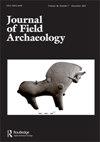历史与水文学:工程独木舟运河在墨西哥湾的河口
IF 1.5
1区 历史学
0 ARCHAEOLOGY
引用次数: 0
摘要
摘要长期以来,当地传说一直将穿越阿拉巴马州墨西哥湾沿岸摩根堡半岛的一处根深蒂固的地貌确定为一条古老的独木舟运河,这一民间鉴定现已得到档案、人工、地质年代、地质考古和水文证据的证实。A 1.39 公里长的运河(地点1BA709)连接了两个河口,牡蛎湾和小泻湖,在伍德兰中期晚期连接莫比尔湾和墨西哥湾,约公元600年。非农业、非等级社会建造如此大型的水利工程似乎很不寻常,但与北美东部其他林地人口更经常完成的那种巨大的景观改变并不矛盾。尽管这些运河无疑加快了当地的旅行、通信和运输,但它们的建设和使用具有更广泛的社会影响。本文章由计算机程序翻译,如有差异,请以英文原文为准。
History and Hydrology: Engineering Canoe Canals in the Estuaries of the Gulf of Mexico
ABSTRACT Local lore has long identified an entrenched feature crossing Fort Morgan peninsula on Alabama’s Gulf of Mexico coast (USA) as an ancient canoe canal, a folk identification now confirmed by archival, artifactual, geochronological, geoarchaeological, and hydrological evidence. A 1.39 km canal (site 1BA709) linked two estuaries, Oyster Bay and Little Lagoon, connecting Mobile Bay to the Gulf of Mexico late in the Middle Woodland period, ca. a.d. 600. Construction of such a large hydraulic engineering feature by a non-agricultural, non-hierarchical society seems unusual but not inconsistent with the sorts of monumental landscape alterations accomplished more routinely by other Woodland populations in eastern North America. Although such canals certainly expedited local travel, communication, and transport, their construction and use had broader social ramifications.
求助全文
通过发布文献求助,成功后即可免费获取论文全文。
去求助
来源期刊

JOURNAL OF FIELD ARCHAEOLOGY
ARCHAEOLOGY-
CiteScore
4.60
自引率
5.30%
发文量
29
期刊介绍:
The Journal of Field Archaeology is an international, refereed journal serving the interests of archaeologists, anthropologists, historians, scientists, and others concerned with the recovery and interpretation of archaeological data. Its scope is worldwide and is not confined to any particular time period. Contributions in English are welcomed from all countries.
 求助内容:
求助内容: 应助结果提醒方式:
应助结果提醒方式:


